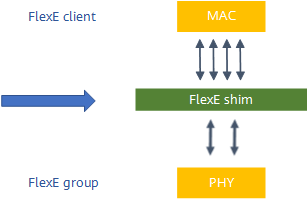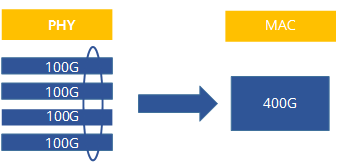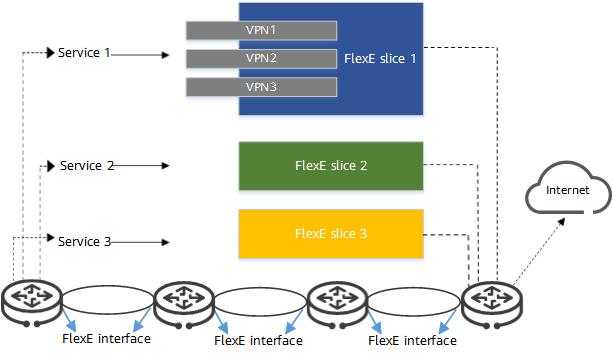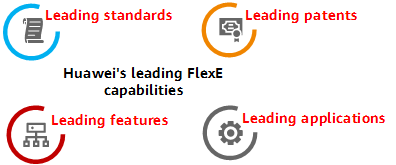What Is FlexE?
Flexible Ethernet (FlexE) is an interface technology used to implement service isolation and network slicing on a bearer network. By eliminating the one-to-one mapping between the MAC and PHY layers, FlexE implements flexible and refined management of interface resources. This not only solves the problem of imbalance between different customers' service requirements and network capabilities, but also meets the requirements of some industries for hard pipe isolation and on-demand bandwidth allocation.
Why Do We Need FlexE?
The need for higher bandwidth on bearer networks is increasing as services and application scenarios become more diverse. In addition, customers want a unified network to transmit various services, such as home broadband, private line access, and mobile bearer services. These factors place increasingly higher requirements on network interfaces.
When standard Ethernet interfaces are used as network interfaces, the following problems exist:
- More flexible bandwidth granularities are not supported: Diverse services and application scenarios require Ethernet interfaces to provide more flexible bandwidth granularities without being restricted by the rate ladder (10G–25G–40G–50G–100G–200G–400G) defined by standards.
- The Ethernet interface capability of IP devices depends on the capability of optical transmission devices, and their development is not synchronous: For example, optical transmission devices do not have 25G or 50G interfaces. However, when IP and optical transmission devices are interconnected, the link rate of the optical transmission device must strictly match the Ethernet rate of the IP device.
- Enhanced QoS capability for multi-service bearing is not supported: Standard Ethernet interfaces perform scheduling based on QoS packet priorities. As a result, long packets will block the pipe, increasing the latency of short packets. In this case, services affect each other.
FlexE resolves these problems and offers the following benefits:
- Supporting more flexible bandwidth granularities: FlexE supports the flexible configuration of interface rates, meeting the requirement for diverse services and application scenarios.
- Decoupling from the capability of optical transmission devices: The Ethernet interface rate of IP devices is decoupled from the link rate of optical transmission devices, meaning that the link rate of optical transmission devices does not need to strictly match the Ethernet interface rate of IP devices. In this way, the existing optical transmission network (OTN) can be utilized to the maximum extent to support Ethernet interfaces with new bandwidths.
- Supporting the enhanced QoS capability for multi-service bearing: FlexE provides channelized hardware isolation on physical-layer interfaces to implement Service Level Agreement (SLA) assurance and isolated bandwidth for services.
FlexE enables different services to be carried over separate slices. It can be used to implement multi-service channelized isolation and on-demand capacity expansion. This important technology supports new types of network construction, application, and development.
How Does FlexE Work?
General Architecture of FlexE
- FlexE client: corresponds to an externally observed user interface that functions in the same way as traditional service interfaces on existing IP/Ethernet networks. FlexE clients can be configured flexibly to meet specific bandwidth requirements. They support Ethernet MAC data streams of various rates, and the data streams are transmitted to the FlexE shim layer as 64B/66B encoded bit streams.
- FlexE shim: functions as a logical layer inserted between the MAC and PHY layers. It implements core FlexE functions through calendar slot distribution.
- FlexE group: consists of various Ethernet PHYs. By default, the PHY bandwidth is divided based on the 5G granularity.

General architecture of FlexE
FlexE Shim
The FlexE shim layer implements the core functions of FlexE. As shown in the following figure, this layer divides each 100G PHY in a FlexE group into 20 slots (called a sub-calendar) for data transmission, with each slot providing 5G bandwidth. Ethernet frames of FlexE clients are partitioned into 64B/66B blocks, which are distributed to multiple PHYs of a FlexE group based on slots through the FlexE shim layer.
The bandwidth of each slot of a 100G PHY in a FlexE group is 5G, and a FlexE client can support multiple rates through different combinations of these slots. Currently, Huawei supports a minimum rate granularity of 1G.

FlexE shim mechanism
The general architecture of FlexE provides three major functions:
- Bonding: Multiple PHYs are bonded to support a higher rate. For example, four 100G PHYs can be bonded to achieve a 400G MAC rate.
- Channelization: Multiple low-rate MAC data streams share one or more PHYs. For example, four MAC data streams (25G, 35G, 20G, and 20G) are carried over one 100G PHY, or three MAC data streams (125G, 150G, and 25G) are carried over three 100G PHYs.
- Sub-rating: MAC data streams with a single low rate share one or more PHYs. For example, a 100G PHY carries only 50G MAC data streams. Sub-rating can be considered a subset of channelization.
What Are the Application Scenarios of FlexE?
Converged transport has become an inevitable trend for IP networks. With the emergence of new applications and services, the existing communications industry faces new challenges in how to achieve on-demand fast networking, flexible resource configuration, and more. Based on its bonding, channelization, and sub-rating functions, and with features such as high-bandwidth interface, network slicing, and physical isolation of channelized sub-interfaces on IP networks, FlexE implements solutions such as on-demand bandwidth allocation and hard pipe isolation. These solutions can be used to support the future service experience-centric network architecture, meeting the development requirements of future bandwidth-intensive services, such as video, VR/AR, and 5G services. Currently, FlexE is mainly applied to scenarios such as ultra-high-bandwidth interface deployment, IP+optical flexible networking, and network slicing.
Using FlexE Bonding to Provide Ultra-High Bandwidth Interfaces
By combining bonding technology with interface rates, FlexE can provide ultra-high bandwidth interfaces. In addition, FlexE can evenly distribute data flows to all physical interfaces through slot-based scheduling, achieving 100% bandwidth utilization and resolving the problems of low bandwidth and low bandwidth utilization on existing links. As shown in the following figure, four 100G PHYs are bonded to achieve a 400G MAC rate.

Using FlexE bonding to provide ultra-high bandwidth interfaces
Using FlexE to Implement IP+Optical Flexible Networking
FlexE interfaces function as user-network interfaces (UNIs) connecting routers to optical transmission devices. Flexible rate matching can be used to implement a one-to-one correspondence between the bandwidth of data flows carried by the UNIs and the bandwidth of the links of interfaces on the optical transmission devices. This considerably simplifies the mapping of routers' FlexE interfaces on the optical transmission devices, reducing device complexity as well as cutting capital expenditure (CAPEX) and operating expense (OPEX). The FlexE standards define three modes for interconnection with optical transmission devices: unaware, termination, and aware. The unaware mode is currently recommended, as it can make full use of existing optical transmission devices to carry FlexE services without requiring hardware upgrades.
Using FlexE to Implement Network Slicing
If a communications network is compared to a transport system, data packets are "vehicles" and the network is a "road." As the number of vehicles increases, urban roads become congested. To alleviate traffic congestion, transportation departments need to plan lanes and manage traffic based on vehicle types and operation modes. For example, they need to set bus rapid transit (BRT) and non-motorized vehicle lanes. This is also the case with a network. To implement connections from people-to-people to thing-to-thing, the number of connections and data traffic will keep increasing rapidly. Without intervention, a network will become more and more congested and complex, eventually affecting the service performance of the network. Similar to the transport system, the communications network also needs to implement "lane" division and traffic management, which are implemented using network slicing. Network slicing provides multiple logical networks (slices) on the same shared network infrastructure. Each logical network serves a specific service type or industry user. Each network slice can flexibly define its logical topology, SLA requirements, reliability, and security level to meet differentiated requirements of different services, industries, or users.
As shown in the following figure, multiple routers use FlexE technology to transmit data. Each of a router's physical interfaces can be configured as multiple FlexE interfaces (logical interfaces). A FlexE interface is equivalent to a physical interface, and bandwidth resources are strictly isolated between FlexE interfaces. In this way, FlexE can be used to implement network slices for different services, achieving a secure, reliable network for multiple purposes.

FlexE technology for network slicing
FlexE interface-based network slicing has the following characteristics:
- Good slicing performance: The latency is stable and no packet loss occurs after slicing; hard isolation is implemented between slices; bandwidth is guaranteed; and services between slices do not affect each other.
- Fine-grained slicing: Huawei supports a minimum slicing granularity of 1G.
- Multiple slices: When working with other resource reservation technologies, such as channelized sub-interface or Flex-channel, FlexE supports hierarchical slicing to meet requirements for more complex service isolation.
- Fast slicing: Slices can be deployed in minutes to implement fast service deployment. Slice resources can be pre-deployed through an intelligent network controller or deployed on demand for services.
Huawei's Leading FlexE Capabilities
Huawei's vision is to bring digital to every person, home and organization for a fully connected, intelligent world. To realize this vision, Huawei actively cooperates with international standards organizations to continuously promote innovation in various fields while improving its strengths. Huawei cooperates with International Telecommunication Union-Telecommunication Standardization Sector (ITU-T), Optical Internetworking Forum (OIF), and Internet Engineering Task Force (IETF) to formulate FlexE standards, and has made great progress in the FlexE architecture layer, FlexE forwarding layer, and FlexE protocol layer.
- FlexE architecture layer
Huawei works with carriers such as China Telecom and China Mobile to promote the research of FlexE interface-based network projects, and cooperates with China Mobile to promote the project initiation of the SPN FlexE cross-connect architecture in ITU-T.
- FlexE forwarding layer
A project was initiated for FlexE2.0 led by Huawei at the OIF, and support for 200G/400G FlexE was added.
- FlexE protocol layer
Huawei has submitted multiple protocol-layer documents, including those for the FlexE interface YANG model and the FlexE control plane architecture, which are widely supported.
Huawei's leading FlexE capabilities drive the rapid development of the communications industry. In the FlexE field, Huawei is a leader in not only standards, but also patents, features, and applications.

Huawei's leading FlexE capabilities
- Leading standards
During the formulation of the FlexE1.0 standard, Huawei contributed 20 of the 94 proposals, making it the largest contributor in the industry.
- Leading patents
In the FlexE technology field, Huawei has 46 important patents and 11 core patents.
- Leading features
Huawei was the first in the industry to refine the slicing granularity from 5G to 1G, supporting small-granularity service bearing.
Huawei was the first in the industry to support FlexE on 50G ports.
- Leading applications
In 2015, Huawei demonstrated the first FlexE prototype.
In 2017, Huawei was the first to complete the FlexE test on China Mobile's network, with zero packet loss and zero preemption.
- Author: Wang Tianshu
- Updated on: 2021-09-30
- Views: 12479
- Average rating:







